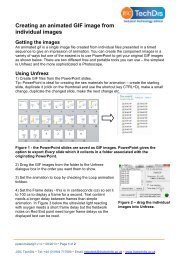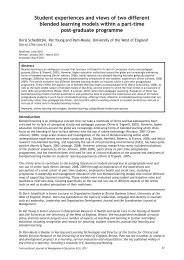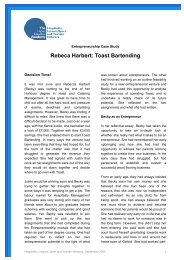Embedding Building Information Modelling (BIM) within the taught ...
Embedding Building Information Modelling (BIM) within the taught ...
Embedding Building Information Modelling (BIM) within the taught ...
You also want an ePaper? Increase the reach of your titles
YUMPU automatically turns print PDFs into web optimized ePapers that Google loves.
Summary<br />
Level 4 (year one of undergraduate study): essentially, <strong>the</strong> key learning outcomes at this stage<br />
are to provide <strong>the</strong> context and background to <strong>the</strong> industry, and why <strong>the</strong> need for significant<br />
productivity improvements exists, set against <strong>the</strong> historical and traditional working<br />
arrangements which have prevailed. This will cover an appreciation of how <strong>the</strong> industry works,<br />
<strong>the</strong> key roles and disciplines involved in delivering projects and identify <strong>the</strong> nature and role of<br />
<strong>the</strong> various stakeholders. It should also include an introduction to <strong>the</strong> way in which information<br />
is prepared, shared and issued and also to <strong>the</strong> technologies being employed to support <strong>BIM</strong> and<br />
promote collaborative working.<br />
Level 5 (year two): outcomes here aim to develop <strong>the</strong> knowledge and understanding of <strong>the</strong> role<br />
of <strong>BIM</strong> as a business driver for collaborative working <strong>within</strong> an integrated supply chain,<br />
considering <strong>the</strong> roles and responsibilities of each <strong>within</strong> a <strong>BIM</strong> approach. Students should be<br />
able to investigate and articulate <strong>the</strong> value proposition for <strong>BIM</strong> from <strong>the</strong> perspective of each<br />
party and consider <strong>the</strong> impact of <strong>BIM</strong> in terms of life cycle and whole life cost on projects.<br />
Level 6 (year three and potentially after year out in industry): at this level <strong>the</strong>re should be a<br />
greater focus on building competence and knowledge around <strong>the</strong> people, systems and process<br />
which are required for <strong>BIM</strong> to be delivered successfully on projects. This should include <strong>the</strong><br />
ability to fully articulate <strong>the</strong> benefits of <strong>BIM</strong>. There should be awareness and appreciation of <strong>the</strong><br />
cultural and organisational impacts of change necessary for <strong>the</strong> adoption of <strong>BIM</strong> both people<br />
issues and practical issues; awareness required of <strong>the</strong> practical measures necessary for <strong>BIM</strong><br />
implementation including understanding of available technologies, means for exchanging data,<br />
standards and protocols; and appreciation of new ways of working in groups/projects—<br />
integrated project team work and collaborative working environments to support <strong>BIM</strong> delivery.<br />
11
















